The global microcellular foam market is forecasted to grow from USD 6,975.6 million in 2025 to approximately USD 21,665.3 million by 2035, recording an absolute increase of USD 14,689.7 million over the forecast period. This translates into a total growth of 210.6%, with the market forecast to expand at a CAGR of 12.0% between 2025 and 2035.
The market size is expected to grow by nearly 3.1X during the same period, supported by increasing demand for lightweight materials, growing automotive industry requirements, and rising adoption of advanced foam technologies across the global packaging, electronics, and medical device industries.
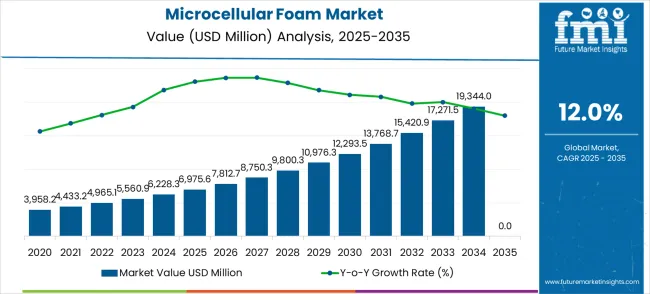
Between 2025 and 2030, the market is projected to expand from USD 6,975.6 million to USD 12,293.5 million, resulting in a value increase of USD 5,317.9 million, which represents 36.2% of the total forecast growth for the decade. This phase of development will be shaped by increasing automotive lightweighting initiatives, rising demand for green packaging solutions, and growing utilization in electronics and medical device applications. Foam technology manufacturers and advanced materials specialists are expanding their microcellular foam production capabilities to address the growing preference for lightweight and high-performance materials in industrial and consumer applications.
From 2030 to 2035, the market is forecast to grow from USD 12,293.5 million to USD 21,665.3 million, adding another USD 9,371.8 million, which constitutes 63.8% of the ten-year expansion. This period is expected to be characterized by the expansion of next-generation foam technologies, the integration of green manufacturing processes for premium microcellular foam products, and the development of specialized foam formulations for emerging applications. The growing focus on material performance optimization will drive demand for advanced microcellular foams with enhanced mechanical properties and improved recyclability characteristics.
Between 2020 and 2024, the market experienced robust growth, driven by increasing automotive industry investments and growing recognition of microcellular foam technology's superior weight reduction capabilities across automotive, packaging, and electronics applications. The market developed as manufacturers recognized the potential for advanced foam materials to enhance product performance while meeting stringent weight reduction. Technological advancement in foam processing methods and material science began prioritizing the critical importance of maintaining structural integrity while reducing material density and improving cost-effectiveness.
| Metric | Value |
|---|---|
| Estimated Value in (2025E) | USD 6,975.6 million |
| Forecast Value in (2035F) | USD 21,665.3 million |
| Forecast CAGR (2025 to 2035) | 12.0% |
Market expansion is being supported by the increasing global demand for lightweight materials and the corresponding shift toward advanced foam technologies that can provide superior weight reduction while meeting industry requirements for high-performance and eco-friendly material solutions. Modern automotive and packaging manufacturers are increasingly focused on incorporating microcellular foams to enhance product efficiency while satisfying demands for reduced environmental impact and improved performance characteristics. Microcellular foams’ proven ability to deliver superior weight reduction, mechanical strength, and processing versatility makes them essential materials for modern manufacturing applications and environmentally conscious product development.
The growing focus on energy efficiency and environmental responsibility is driving demand for high-quality microcellular foam products that can support distinctive performance capabilities and premium material positioning across automotive, packaging, and electronics categories. Manufacturer preference for materials that combine weight reduction excellence with environmental compatibility is creating opportunities for innovative microcellular foam implementations in both traditional and emerging industrial applications. The rising influence of regulatory requirements for fuel efficiency and eco-conscious practices is also contributing to increased adoption of premium microcellular foam products that can provide authentic high-performance lightweight characteristics.
The microcellular foam market represents a high-growth advanced materials opportunity driven by the global lightweighting megatrend, with the market projected to expand from USD 6,975.6 million in 2025 to USD 21,665.3 million by 2035 at a strong 12.0% CAGR, a 3.1X growth trajectory powered by automotive fuel efficiency requirements, green packaging demands, and electronics miniaturization needs. This technology delivers superior weight reduction while maintaining structural integrity through microscopic cellular structures that provide exceptional strength-to-weight ratios.
The market benefits from regulatory pressures for fuel economy improvements, environmental sustainability mandates, and performance optimization requirements across multiple industries. Polyurethane microcellular foam dominates with 35.2% market share due to its processing versatility and established manufacturing infrastructure, while automotive applications lead demand given the industry's aggressive lightweighting initiatives. Geographic opportunities are strongest in China (16.2% CAGR) and India (15.0% CAGR), where automotive manufacturing expansion and industrial development create ideal growth conditions for advanced materials adoption.
Pathway A - Automotive Lightweighting Solutions. The dominant application segment faces increasing regulatory pressure for fuel efficiency and emission reductions, driving demand for advanced lightweight materials. Companies developing automotive-grade microcellular foams with crashworthiness certifications, temperature stability, and cost-effective manufacturing will capture this primary growth driver. Expected revenue pool: USD 8,000-12,000 million.
Pathway B - Polyurethane Technology Leadership. The leading material segment offers optimal processing characteristics and established supply chains. Providers developing next-generation polyurethane microcellular foams with enhanced mechanical properties, improved sustainability profiles, and broader application compatibility will maintain market leadership in this dominant category. Opportunity: USD 6,000-9,000 million.
Pathway C - Eco-friendly Packaging Applications. Growing environmental regulations and consumer preferences drive demand for lightweight, recyclable packaging materials. Developing food-safe microcellular foams with biodegradable characteristics and superior protective properties addresses the expanding green packaging market beyond automotive applications. Revenue uplift: USD 3,000-5,000 million.
Pathway D - Geographic Expansion in High-Growth Markets. China and India's manufacturing expansion create substantial opportunities for materials suppliers. Local production capabilities, automotive industry partnerships, and cost-competitive manufacturing strategies enable market penetration in these rapidly industrializing regions, driving global demand. Pool: USD 4,000-7,000 million.
Pathway E - Electronics and Medical Device Applications. Miniaturization trends in electronics and advanced medical devices require specialized foam materials with precise properties. Developing high-performance microcellular foams with electromagnetic compatibility, biocompatibility, and precision manufacturing capabilities serves these high-value, growing market segments. Expected upside: USD 2,000-3,500 million.
Pathway F - Advanced Processing Technology Development. Next-generation manufacturing requires improved foam processing techniques with enhanced control and efficiency. Companies investing in automated production systems, quality optimization technologies, and green manufacturing processes will create competitive advantages through superior cost structures and product consistency. USD 1,500-2,500 million.
Pathway G - Metal and Ceramic Microcellular Foams. Specialized applications requiring extreme performance characteristics drive demand for advanced material systems. Developing metal and ceramic microcellular foams for aerospace, defense, and high-temperature applications creates premium market opportunities with superior margins and performance differentiation. Pool: USD 1,000-2,000 million.
Pathway H - Circular Economy and Recycling Solutions. Environmental regulations increasingly require end-of-life material management and recycling capabilities. Developing recyclable microcellular foam formulations and closed-loop manufacturing systems addresses sustainability requirements while creating new revenue streams from material recovery and reprocessing services. Expected revenue: USD 800-1,500 million.
The market is segmented by material type, application, and region. By material type, the market is divided into polyurethane microcellular foam, metal microcellular foam, ceramic microcellular foam, and others. Based on application, the market is categorized into automotive, packaging, electronics, medical devices, sporting goods, and footwear. Regionally, the market is divided into North America, Europe, East Asia, South Asia & Pacific, Latin America, and the Middle East & Africa.
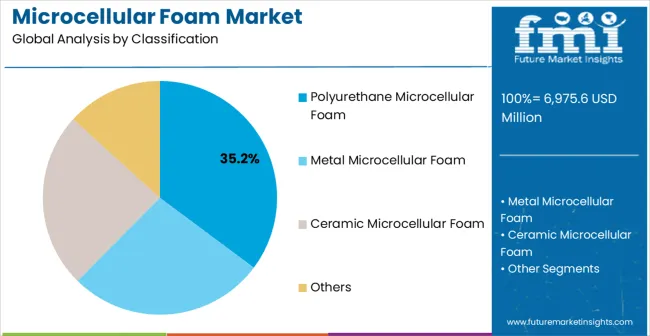
The polyurethane microcellular foam segment is projected to account for 35.2% of the microcellular foam market in 2025, reaffirming its position as the leading material type category. Automotive manufacturers and packaging companies increasingly utilize polyurethane microcellular foam for its superior processing characteristics, consistent performance properties, and ease of integration in manufacturing processes across diverse industrial applications. Polyurethane microcellular foam technology's established chemistry and reliable processing directly address the industrial requirements for versatile foam materials and efficient production processes in commercial manufacturing operations.
This material segment forms the foundation of modern microcellular foam applications, as it represents the technology with the greatest processing versatility and established manufacturing compatibility across multiple industrial systems. Manufacturer investments in polyurethane chemistry optimization and processing enhancement continue to strengthen adoption among industrial foam producers. With companies prioritizing material performance and manufacturing efficiency, polyurethane microcellular foam aligns with both technical objectives and production requirements, making it the central component of comprehensive lightweight material strategies.
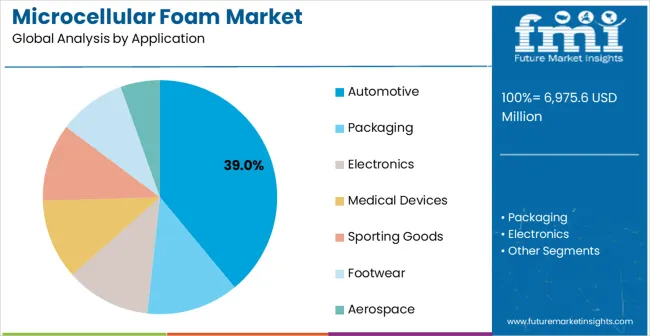
Automotive applications are projected to account 39.0% share of microcellular foam demand in 2025, underscoring their critical role as the primary application for lightweight materials in automotive manufacturing and component production operations. Automotive manufacturers prefer microcellular foams for their exceptional weight reduction capabilities, crashworthiness properties, and ability to maintain consistent performance while supporting vehicle efficiency requirements during automotive production. Positioned as essential materials for high-performance automotive applications, microcellular foams offer both weight reduction and structural performance advantages.
The segment is supported by continuous growth in automotive lightweighting initiatives and the growing availability of specialized foam formulations that enable enhanced vehicle efficiency and performance optimization at the manufacturing level. Automotive manufacturers are investing in advanced materials technologies to support fuel efficiency regulations and emission reduction targets. As the automotive industry continues to evolve and manufacturers seek superior lightweight material solutions, automotive applications will continue to dominate the application landscape while supporting technology advancement and vehicle efficiency strategies.
The microcellular foam market is advancing rapidly due to increasing automotive lightweighting investments and growing demand for eco-friendly material solutions that emphasize superior weight reduction across automotive, packaging, and electronics applications. The market faces challenges, including complex processing requirements for specialized foam grades, higher material costs compared to conventional alternatives, and technical limitations in certain high-temperature applications. Innovation in processing technology optimization and environmentally conscious material development continues to influence market development and expansion patterns.
The growing adoption of microcellular foams in eco-friendly packaging and electronics protection applications is enabling material manufacturers to develop products that provide distinctive environmental benefits while commanding premium positioning and enhanced performance characteristics. Advanced applications offer superior protection while allowing more sophisticated, environmentally conscious development across various packaging categories and electronics segments. Manufacturers are increasingly recognizing the competitive advantages of green foam positioning for premium product development and eco-conscious market penetration.
Modern microcellular foam suppliers are incorporating advanced processing technologies, automated production systems, and quality optimization processes to enhance foam properties, improve manufacturing efficiency, and meet industry demands for consistent and high-performance lightweight materials. These programs improve material performance while enabling new applications, including specialized automotive components and advanced packaging systems. Advanced technology integration also allows suppliers to support premium market positioning and manufacturing leadership beyond traditional commodity foam materials.
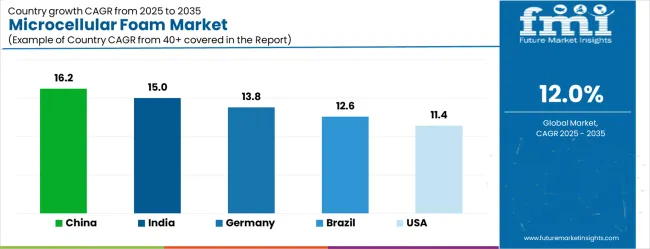
| Country | CAGR (2025 to 2035) |
|---|---|
| China | 16.2% |
| India | 15.0% |
| Germany | 13.8% |
| Brazil | 12.6% |
| USA | 11.4% |
| UK | 10.2% |
| Japan | 9.0% |
The market is experiencing exceptional growth globally, with China leading at a 16.2% CAGR through 2035, driven by the rapidly expanding automotive manufacturing sector, massive investments in packaging industry modernization, and increasing adoption of lightweight materials technologies. India follows at 15.0%, supported by a growing automotive industry, rising electronics manufacturing, and expanding consumer goods production capabilities.
Germany shows growth at 13.8%, focusing advanced materials technology and premium automotive manufacturing. Brazil records 12.6%, focusing on emerging automotive applications and packaging industry development. The USA demonstrates 11.4% growth, prioritizing automotive innovation and advanced materials development.
The UK exhibits 10.2% growth, supported by automotive technology advancement and advanced manufacturing capabilities. Japan shows 9.0% growth, focusing precision manufacturing excellence and high-quality materials production.
The report covers an in-depth analysis of 40+ countries; top-performing countries are highlighted below.
China is projected to exhibit exceptional growth with a CAGR of 16.2% through 2035, driven by the rapidly expanding automotive manufacturing sector and massive government investments in advanced materials development across major industrial hubs. The country's growing automotive production capacity and increasing adoption of lightweight materials technologies are creating substantial demand for high-performance foam materials in both established and emerging automotive applications. Major foam technology manufacturers and automotive suppliers are establishing comprehensive research and production capabilities to serve both domestic consumption and export markets.
India is expanding at a CAGR of 15.0%, supported by the growing automotive industry, increasing electronics manufacturing, and expanding consumer goods production applications. The country's developing manufacturing ecosystem and expanding industrial capabilities are driving demand for lightweight materials across both automotive production and packaging applications. International foam companies and domestic materials manufacturers are establishing comprehensive distribution and production capabilities to address growing market demand for advanced foam solutions.
Germany is projected to grow at a CAGR of 13.8% through 2035, driven by the country's advanced materials technology sector, premium automotive manufacturing capabilities, and leadership in engineering excellence solutions. Germany's sophisticated automotive industry culture and willingness to invest in high-performance materials are creating substantial demand for both standard and specialized microcellular foam varieties. Leading technology companies and automotive manufacturers are establishing comprehensive innovation strategies to serve both European markets and growing international demand.
Brazil is projected to grow at a CAGR of 12.6% through 2035, supported by the country's expanding automotive sector, growing packaging applications, and increasing adoption of lightweight materials requiring advanced foam solutions. Brazilian manufacturers and international companies consistently seek reliable foam materials that enhance product performance for both domestic applications and regional markets. The country's position as a regional automotive hub continues to drive innovation in materials technology applications and manufacturing standards.
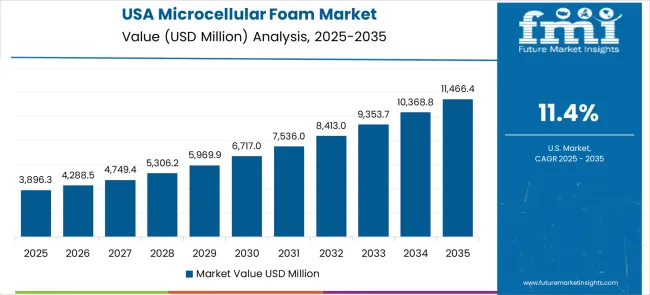
The United States is projected to grow at a CAGR of 11.4% through 2035, supported by the country's advanced automotive sector, materials technology innovation capabilities, and established leadership in high-performance foam solutions. American automotive companies and materials manufacturers prioritize performance, sustainability, and regulatory compliance, making microcellular foam an essential material for both domestic production and technology-oriented manufacturing. The country's comprehensive research capabilities and technical expertise support continued market development.
The United Kingdom is projected to grow at a CAGR of 10.2% through 2035, supported by the country's automotive technology sector, advanced manufacturing capabilities, and established expertise in materials innovation solutions. British manufacturers' focus on innovation, and performance with steady demand for advanced microcellular foam materials. The country's attention to automotive excellence and materials optimization drives consistent adoption across both traditional automotive and emerging lightweight applications.
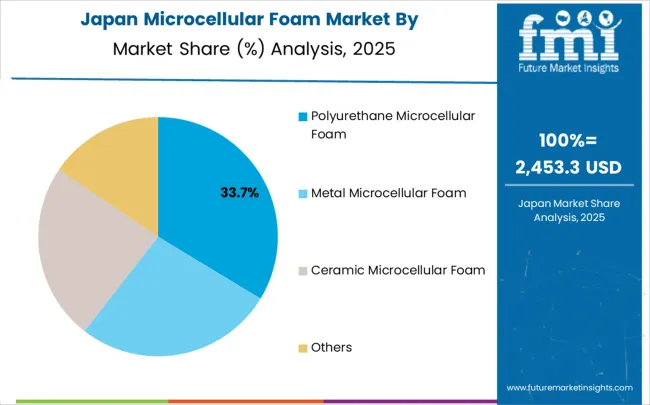
Japan is projected to grow at a CAGR of 9.0% through 2035, supported by the country's precision manufacturing excellence, advanced materials technology expertise, and established reputation for producing superior foam materials while working to enhance processing efficiency capabilities and develop next-generation lightweight technologies. Japan's materials industry continues to benefit from its reputation for delivering high-quality industrial products while focusing on innovation and manufacturing precision.
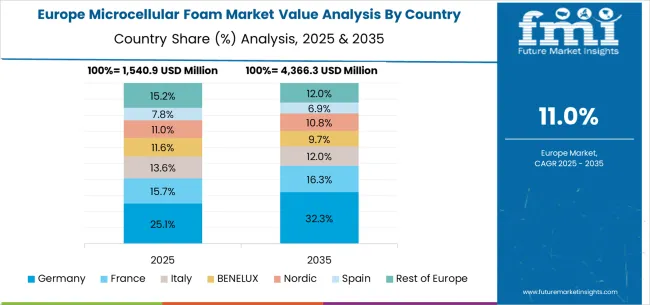
The microcellular foam market in Europe is projected to grow from USD 1,824.3 million in 2025 to USD 5,248.7 million by 2035, registering a CAGR of 11.2% over the forecast period. Germany is expected to maintain its leadership position with a 31.4% market share in 2025, remaining stable at 31.2% by 2035, supported by its advanced materials technology sector, precision automotive manufacturing industry, and comprehensive innovation capabilities serving European and international markets.
The United Kingdom follows with a 20.7% share in 2025, projected to reach 20.9% by 2035, driven by automotive technology development programs, advanced manufacturing capabilities, and a growing focus on lightweight materials solutions for premium applications. France holds a 17.8% share in 2025, expected to maintain 17.6% by 2035, supported by automotive industry demand and advanced materials applications, but facing challenges from market competition and economic considerations. Italy commands a 13.5% share in 2025, projected to reach 13.7% by 2035, while Spain accounts for 9.2% in 2025, expected to reach 9.4% by 2035.
The Netherlands maintains a 4.6% share in 2025, growing to 4.7% by 2035. The Rest of Europe region, including Nordic countries, Eastern Europe, Belgium, Switzerland, and Austria, is anticipated to hold 16.8% in 2025, declining slightly to 16.5% by 2035, attributed to mixed growth patterns with strong expansion in some automotive markets balanced by moderate growth in smaller countries implementing lightweight materials development programs.
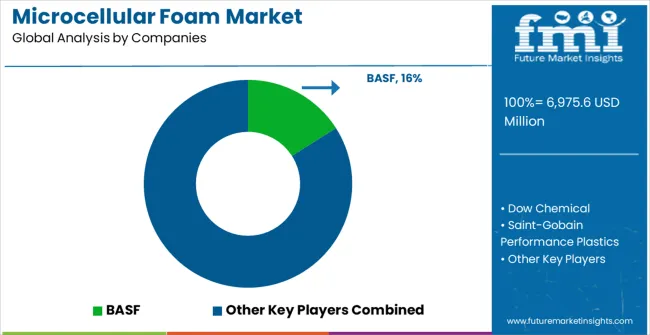
The market is characterized by competition among established chemical companies, specialized foam manufacturers, and integrated materials solution suppliers. Companies are investing in advanced processing technologies, foam formulation optimization systems, application-specific product development, and comprehensive technical support capabilities to deliver consistent, high-performance, and reliable microcellular foam products. Innovation in processing efficiency enhancement, and customized materials solutions is central to strengthening market position and customer satisfaction.
BASF leads the market with a strong focus on chemical innovation and comprehensive materials solutions, offering sophisticated microcellular foam products with focus on performance reliability and application versatility excellence. Dow Chemical provides integrated chemical and materials capabilities with a focus on automotive applications and global manufacturing networks.
Saint-Gobain Performance Plastics delivers advanced materials technology with a focus on innovation and premium product development. Huntsman specializes in polyurethane technologies with focus on technical expertise and foam optimization. Evonik focuses on specialty chemicals and advanced materials with sophisticated processing capabilities. Rogers Aerospace emphasizes aerospace and electronics applications with a focus on high-performance foam solutions and technical excellence.
| Items | Values |
|---|---|
| Quantitative Units (2025) | USD 6,975.6 million |
| Material Type | Polyurethane Microcellular Foam, Metal Microcellular Foam, Ceramic Microcellular Foam, Others |
| Application | Automotive, Packaging, Electronics, Medical Devices, Sporting Goods, Footwear |
| Regions Covered | North America, Europe, East Asia, South Asia & Pacific, Latin America, Middle East & Africa |
| Countries Covered | United States, Canada, United Kingdom, Germany, France, China, Japan, South Korea, India, Brazil, Australia and 40+ countries |
| Key Companies Profiled | BASF, Dow Chemical, Saint-Gobain Performance Plastics, Huntsman, Evonik, Rogers Aerospace, MATSUI, Griswold International, 3M, ERA Polymers, TOPWIN, Shincell, Aearo Technologies, Ningbo Micro-foam Technology, Wanhua Chemical Group, Shanghai Huayi Group, Cymat Technologies, Alulight International, and ERG Materials and Aerospace |
| Additional Attributes | Dollar sales by material type and application, regional demand trends, competitive landscape, technological advancements in foam processing, weight reduction development initiatives, enhancement programs, and automotive integration strategies |
The global commercial vehicle AMT transmission market is estimated to be valued at USD 3,584.4 million in 2025.
The market size for the commercial vehicle AMT transmission market is projected to reach USD 7,667.2 million by 2035.
The commercial vehicle AMT transmission market is expected to grow at a 7.9% CAGR between 2025 and 2035.
The key product types in commercial vehicle AMT transmission market are 6-8 gears, 10-12 gears and 16 gears and above.
In terms of application, medium and heavy trucks segment to command 65.0% share in the commercial vehicle AMT transmission market in 2025.






Our Research Products

The "Full Research Suite" delivers actionable market intel, deep dives on markets or technologies, so clients act faster, cut risk, and unlock growth.

The Leaderboard benchmarks and ranks top vendors, classifying them as Established Leaders, Leading Challengers, or Disruptors & Challengers.

Locates where complements amplify value and substitutes erode it, forecasting net impact by horizon

We deliver granular, decision-grade intel: market sizing, 5-year forecasts, pricing, adoption, usage, revenue, and operational KPIs—plus competitor tracking, regulation, and value chains—across 60 countries broadly.

Spot the shifts before they hit your P&L. We track inflection points, adoption curves, pricing moves, and ecosystem plays to show where demand is heading, why it is changing, and what to do next across high-growth markets and disruptive tech

Real-time reads of user behavior. We track shifting priorities, perceptions of today’s and next-gen services, and provider experience, then pace how fast tech moves from trial to adoption, blending buyer, consumer, and channel inputs with social signals (#WhySwitch, #UX).

Partner with our analyst team to build a custom report designed around your business priorities. From analysing market trends to assessing competitors or crafting bespoke datasets, we tailor insights to your needs.
Supplier Intelligence
Discovery & Profiling
Capacity & Footprint
Performance & Risk
Compliance & Governance
Commercial Readiness
Who Supplies Whom
Scorecards & Shortlists
Playbooks & Docs
Category Intelligence
Definition & Scope
Demand & Use Cases
Cost Drivers
Market Structure
Supply Chain Map
Trade & Policy
Operating Norms
Deliverables
Buyer Intelligence
Account Basics
Spend & Scope
Procurement Model
Vendor Requirements
Terms & Policies
Entry Strategy
Pain Points & Triggers
Outputs
Pricing Analysis
Benchmarks
Trends
Should-Cost
Indexation
Landed Cost
Commercial Terms
Deliverables
Brand Analysis
Positioning & Value Prop
Share & Presence
Customer Evidence
Go-to-Market
Digital & Reputation
Compliance & Trust
KPIs & Gaps
Outputs
Full Research Suite comprises of:
Market outlook & trends analysis
Interviews & case studies
Strategic recommendations
Vendor profiles & capabilities analysis
5-year forecasts
8 regions and 60+ country-level data splits
Market segment data splits
12 months of continuous data updates
DELIVERED AS:
PDF EXCEL ONLINE
Foam Type Vacuum Gripping System Market Size and Share Forecast Outlook 2025 to 2035
Foam Mixing Machine Market Size and Share Forecast Outlook 2025 to 2035
Foam Market Size and Share Forecast Outlook 2025 to 2035
Foam-Free Pad Formers Market Size and Share Forecast Outlook 2025 to 2035
Foam Cups Market Size and Share Forecast Outlook 2025 to 2035
Foam Bottle Technology Market Size and Share Forecast Outlook 2025 to 2035
Foaming Agents Market Size and Share Forecast Outlook 2025 to 2035
Foam Glass Granulate Market Size and Share Forecast Outlook 2025 to 2035
Foam Plastics Market Size and Share Forecast Outlook 2025 to 2035
Foaming Creamer Market Size and Share Forecast Outlook 2025 to 2035
Foam Tape Market Size and Share Forecast Outlook 2025 to 2035
Foam Glass Market Size and Share Forecast Outlook 2025 to 2035
Foamer Pump Market Size, Share & Forecast 2025 to 2035
Foam Food Container Market Size and Share Forecast Outlook 2025 to 2035
Foam Mesh Sleeves Market Growth - Demand & Forecast 2025 to 2035
Foam Edge Protectors Market Size and Share Forecast Outlook 2025 to 2035
Foamer Bottle Market Size and Share Forecast Outlook 2025 to 2035
Foam Cap Liners Market Size and Share Forecast Outlook 2025 to 2035
Foam Pouch Market Analysis - Demand, Size & Industry Outlook 2025 to 2035
Foam Cooler Box Market Analysis - Growth & Trends 2025 to 2035

Thank you!
You will receive an email from our Business Development Manager. Please be sure to check your SPAM/JUNK folder too.
Chat With
MaRIA